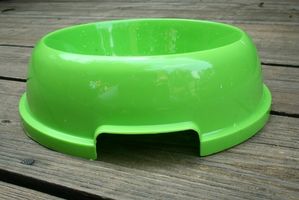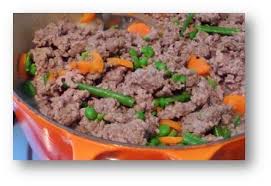Dog owners have a way – sometimes within DAYS of first becoming dog owners – of becoming EXPERTS on animal behavior. It blows my mind. These are people who observe their animals displaying interesting or curious behaviors and make up things like “dogs like being put in tiny cages, actually, because of when their ancestors were pack animals and lived in caves.”
That said, a reader sent me an email inquiring about a particular behavior that she has observed in her lab. This reader is not one of the above-described self-proclaimed experts. This reader is generally awesome.
She writes:
My dog is pushing around her food, her food dish, or anything in the area. She noses it around every time before she eats, sometimes for a significant period of time. This video is of her pushing the towel under the dish around (which I put there to stop her from pushing the dish entirely across the tile floor and spilling food everyone). Sometimes she noses the food around and doesn’t even bother to eat any. What is this all about?
One day she decided to set up a spycam so she could catch her dog in the act. She sent me the video and permitted me to upload it for the world to see:
It turns out that this behavior appears fairly common, and inquiries abound online in various forums and whatnot. Enter the self-proclaimed experts. One offers;
Many dogs push their food bowls around; it might be vestigial to the dog’s foraging instinct. Many dogs also pick food out of the bowl and carry it to another location to eat it.
Another suggests;
Depending on the breed of your dog, and dominance level, it’s food looks rather bleak. Meaning that it’s looking for something more alive; this would be the hunter in them call out. Ever wonder why dogs love a good squeaker? It’s because it resembles a dying animal.
Here’s a selection of other gems,
Maybe try switching food brands
Maybe, just maybe, she doesn’t like the shape of the bowl it may be not the most convenient shape for her to eat out of. Having just a dog brain she doesn’t know it is a permanent shape. But more than likely it is just an inherited behavior left over from before dogs trained humans to be pet owners. Back then the dog (or dawg, or even dogg, spelling having not been domesticated yet) ate things it killed or found already dead. Sometimes the prey might not be dead yet and might try to bite back so Dog would need to check and one way to check was just give it a push and see if it moved.
I think they want you to pay some attention to them….They can’t speak so we have to listen to them without hearing words…If I were a dog pushing my bowls around I would be saying..I am bored..I am lonely eating alone every night, no one validating me…I am tired of this same ole’ crap all the time…
He’s trying to get on your nerves, or he wants attention. Both ways are the same. Your dog and my dog know that once he does something bad, he’ll get your attention and you might scream at him or maybe slap his nose for him to stop, but he/she thinks it’s fun.
I think perhaps they feel they are “hunting” the food and then eat it.
If I was going to make up a hypothesis, I might conjecture that pushing food around with the nose will indicate if the food is beginning to rot, as bugs and other critters that munch on dead flesh tend to be found underneath the food item.
Time for some actual research.
How about first we knock down all those lay explanations:In wild animals, food selection begins with foraging (or hunting, for carnivores) behavior, and ends with food consumption. Through domestication, however, hunting behavior in dogs seems to have been genetically modified if not entirely eradicated. Some evidence that this is so comes from studies of “village” or feral dogs. These are dogs that generally survive by scavenging, raising the possibility that domesticated dogs have not maintained a fully functional repertoire of hunting behaviors. It should be noted, however, that not much is known about how wolves decide what is palatable (e.g. appearance, odor, texture, flavor), so it is hard to determine if dogs’ preferences in that respect have changed in domestication. So it is unlikely that any food-related behavior you observe in a domesticated dog is “leftover” from their wolf ancestors. Possible, but unlikely.
Then, I asked this reader a few questions: are there other dogs in the house? Yes, a male dog. Does she generally feed the dog the same food every day? Yes.I could not find anything in the literature directly addressing this issue. Here are some things we do know about food selection in domesticated dogs, and my best guess as to the explanation of this particular dog’s behavior:
(1) It is certain that odor plays a strong role in food selection, because anosmic dogs (who can’t smell) show reduced discrimination between types of meat that are otherwise highly discriminable.
(2) Dogs combine olfactory information (smell) with social information to select what type of food they want. In one study, dogs preferred eating something that smelled like the breath of another dog who had recently been fed.
I wonder if perhaps Shug (white poodle) smelled something on the other dog’s breath, and was looking for it. This reader insisted that the two dogs are fed the same foods. It is possible that there is some odor produced by the interaction of the other dog’s saliva and the food that Shug was trying to find in her food bowl.
One other bit of info that I stumbled across concerns liberality in dogs. Laterality is an observable measure of functional asymmetry in the brain. The human brain, for example, is strongly left-lateralized for language. This means that much of language processing occurs on the left side of the brain. Human handedness (whether you favor your right or left hand) has to do with laterality as well. Human handedness may be a topic for another day – this day, we shall focus on dog paw-edness. Do dogs favor one paw over the other?So the answer is yes, and is actually related to their sex. Females tend to prefer the right paw, and males tend to prefer the left paw. What is most interesting to me is that task #3 was a food retrieval task.
I am well aware that I might be reaching here and over-interpreting – but I wonder if perhaps Shug, if she is right-pawed like most other female dogs, is simply trying to move the food away from the wall. Kind of like, if you’re at a restaurant, and you’re right handed, it totally sucks to be the guy at the end of the booth with your right hand against the wall.
So, there you have it. Both may be stretching it a little, but you’ve got two workable hypotheses that are totally testable.





